The workplace is the operational heart of a business, a symbol of its culture, and a critical factor in employee productivity and satisfaction. As companies evolve, their spatial needs inevitably change. Growth, technological advancement, shifting workstyles, and the desire to project a modern brand image can often force leadership to confront a significant strategic decision: refurbishing the existing office space or relocating to a new one entirely. This choice carries substantial financial, operational, and cultural implications.
A hasty decision can lead to wasted capital, operational disruption, and a negative impact on morale, while a well-considered one can catalyze growth, innovation, and enhanced collaboration. The evaluation process requires a meticulous analysis of the company’s current position, its strategic goals for the future, and a clear-eyed assessment of the practicalities involved in both avenues.
Read on to learn whether office refurbishment or relocation is best for you.
Evaluating the Case for Office Refurbishment
A refurbishment, often termed a renovation or fit-out, involves upgrading and modernizing an existing office space without changing its location. This path is frequently pursued when the fundamental structure of the building is sound, but the interior environment requires significant improvement to meet contemporary standards.
Some key advantages of refurbishment:
- Cost-Effectiveness: In many scenarios, refurbishment is a more financially prudent option. It avoids the substantial costs associated with relocation, such as lease termination fees, new security deposits, elevated rental rates in a new building, and the physical cost of moving equipment and assets.
- Minimized Operational Disruption: While a refurbishment requires careful phasing, it typically allows your business to remain operational. Skilled project managers can plan the work in sections or during off-hours, enabling employees to continue working with minimal interruption.
- Preservation of Location Benefits: If your organization is situated in an established, desirable location with excellent access for clients and employees, a proven commute pattern, and proximity to amenities, refurbishment allows it to retain these hard-won advantages.
- Sustainability: Choosing to refurbish is inherently a more sustainable option. It reduces the waste associated with a full demolition and move and minimizes the carbon footprint of constructing an entirely new building interior.
Therefore, engaging with experienced Office Fitout Professionals early in decision-making can provide invaluable clarity. These experts can conduct a thorough feasibility study, offering data-driven insights into the structural possibilities of an existing building versus the opportunities presented by a new location. Their expertise can help translate your company’s vision into a tangible, functional, and cost-effective reality, whether through a transformative renovation or a brand-new build-out.
However, the refurbishment process is not without its hurdles. Hidden structural issues, such as outdated electrical wiring or plumbing, asbestos abatement, or non-compliance with current building codes, can be discovered mid-project, leading to unforeseen costs and delays.
Furthermore, the existing floorplate may impose inherent limitations on the desired office layout, potentially restricting the open, collaborative spaces many modern companies seek to create.
Analyzing the Rationale for Office Relocation
Relocation involves the strategic decision to leave current premises for a new one. This is a more radical step, typically considered when the existing space can no longer support the company’s operational needs or strategic direction.
Some key advantages of relocation include:
- A Truly Blank Canvas: Moving to a new property offers the ultimate freedom to design a workplace from the ground up. Existing walls, columns, or infrastructure don’t constrain companies.
- Scalability and Future Growth: A primary driver for relocation is the need for more space. If an existing location can’t accommodate horizontal or vertical expansion, then moving is the only viable option.
- Enhanced Brand Image and Talent Acquisition: A modern, well-located office can serve as a powerful recruitment tool and statement of success. Relocating to a vibrant, amenity-rich district can refresh your company’s image, making it more attractive to top talent who prioritize a high-quality work environment and convenient location.
- Potential for Operational Efficiency: A move presents an opportunity to renegotiate operational costs. A newer building typically features greater energy efficiency, lower maintenance requirements, and modern building management systems, which can lead to long-term savings on utilities and upkeep.
On the other hand, some potential challenges of relocation can include:
The financial investment is typically much higher, encompassing not only the new office fit-out costs, but also moving expenses, new office furniture, potential lease break penalties, and often higher rental rates. The disruption to business operations is more profound as the physical move can take time, and employees face the challenge of adapting to a new commute and neighborhood, which can temporarily affect morale and productivity.
Making the Strategic Decision: Key Factors to Consider
Arriving at the right choice requires a disciplined, analytical approach. Leadership teams must weigh several critical factors, including:
Financial Analysis
Develop a comprehensive total cost projection for both options. For refurbishment, include construction, office design fees, permits, and temporary relocation costs for employees during phases of work. For business relocation, factor in new lease costs, fit-out construction, moving services, technology infrastructure installation, and any penalties from breaking the current lease.
Business Needs and Growth Trajectory
Assess the business’s current and future needs honestly. Does the existing space have the capacity for a 20% or 50% increase in staff? Can the layout effectively support new collaboration and technology requirements? Relocation may be the only sustainable solution if the growth plan is aggressive and the current space is a barrier.
Lease Terms and Property Conditions
The terms of the existing lease are decisive. If the lease is nearing expiration, it presents a natural decision point. A long remaining term with favorable rates might incentivize a refurbishment, while an expiring lease in a deteriorating building would lean toward relocation.
Conclusion
The dilemma between office refurbishment and relocation lacks a universal answer. It’s a complex strategic calculation unique to each organization. By keeping the information mentioned above in mind, you can navigate the complexities of both paths to deliver a workplace that drives business success.
View the original article and our Inspiration here


Leave a Reply